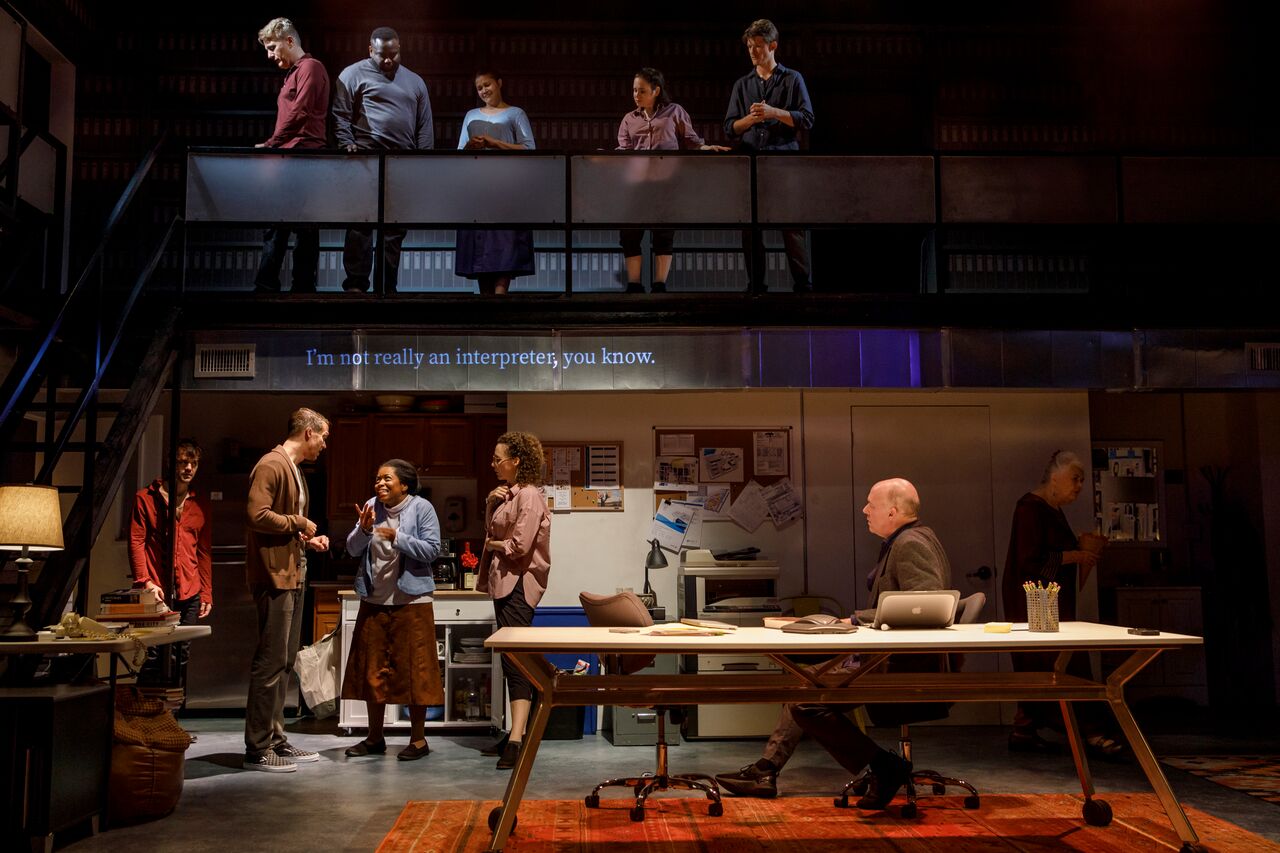
I Was Most Alive With You
By Craig Lucas; Directed by Tyne Rafaeli
Off Broadway, Play
Runs through 10.14.18
Playwrights Horizons, 416 West 42nd Street
by Emily Cordes on 9.24.18
 The cast of I Was Most Alive With You. Photo by Joan Marcus.
The cast of I Was Most Alive With You. Photo by Joan Marcus.
BOTTOM LINE: Diverse characters address fate and agency in this striking modern take on the Book of Job.
The biblical story of Job, a righteous man faced with immense suffering, serves as one of Western culture’s most iconic parables in its exploration of injustice, faith, and resilience. Put simply, our fascination with this story epitomizes our need to understand the circumstances we face and to bring meaning to an unfair world. Historical and social progress notwithstanding, humanity grapples with these same questions throughout the ages, and it is such dilemmas that form the basis of I Was Most Alive With You. Applying the Book of Job’s queries to a modern family’s tale of disconnect, struggle, and redemption, playwright Craig Lucas articulates the fragility and hope of our shared existence.
In 2009 Los Angeles, amidst the brewing storm of housing crisis, industrial clash, and natural disaster, the characters of I Was Most Alive With You congregate for an unexpectedly life-altering Thanksgiving. At the behest of his elderly mother Carla (Lois Smith), screenwriter Ash (Michael Gaston) gathers with his wife Pleasant (Lisa Emery) and writing partner Astrid (Marianna Bassham) in fraught celebration with Ash and Pleasant’s deaf son Knox (Russell Harvard) and Knox’s boyfriend Farhad (Tad Cooley). Despite Carla’s unifying presence, tensions run high on multiple levels, the most prominent being the rift between Pleasant and Knox, whose choice to communicate via sign language serves as a direct rebuff to his mother’s preference for lip-reading and prior efforts to teach her son to speak.
The presence of Mariama (Gameela Wright), Carla’s friend-turned-interpreter, ironically widens this gap as Knox uses her mediation to ostracize his mother as the group’s sole non-signer. This choice, paired with Pleasant’s status as the lone Protestant among Jewish in-laws and third wheel in Ash and Astrid’s partnership, breeds further discontent. Similarly, with his checkered past and active drug use, Farhad’s presence as Knox’s long-term lover confounds both the family’s stability and the sobriety of Ash and Knox, both former addicts. Nonetheless, an uneasy hope prevails as the family gives thanks for the continued success of Carla’s business ventures, Ash and Astrid’s acclaimed sitcom, and Knox’s ability to transcend his struggles as a role model for Farhad and the Deaf students he mentors. When guests’ questionable choices and long-buried secrets emerge, the ensuing fallout throws the family into cataclysmic decline. And as the characters navigate their new reality, each must confront his or her personal powerlessness and efforts to grasp the inexplicable.
Lucas voices his source material’s universality through an array of social, cultural, and linguistic perspectives, and the show’s powerful cast strengthens this effect. As Knox, the tale’s Job figure, Harvard is poignant in his grace and suffering, his downward spiral visceral to watch. Though Pleasant’s martyr complex blinds her to her errors and self-isolation, we empathize with her dogged struggle to help her son and sense of rejection when these efforts are ignored. Gaston and Cooley wrestle with guilt and responsibility as Ash and Farhad’s love for Knox unearths their wayward pasts and tenuous futures. Bassham and Smith bring insight and comic relief to their respective roles of wise-but-vested witness and godlike figure that unites then takes away. The group’s diversity further highlights the theme of interpretation as Jewish, Protestant, Buddhist, and atheist theories clash in characters’ assessments of divine presence and free will. The Twelve-Step concept of surrender, and Jehovah’s Witnesses’ faith in redemptive action, lend additional nuance.
The play’s focus on the Deaf community also highlights its issues of exclusion, communication, and personal choice. Stationed on a catwalk above the stage, a shadow cast (Beth Applebaum as Astrid, Christina Cogswell as Carla, Harold Foxx as Knox, Seth Gore as Ash, Amelia Hensley as Pleasant, Anthony Natale as Farhad, and Alexandria Wailes as Mariama) enacts the dialogue in American Sign Language, while supertitles translate onstage signing to written English. The combined effect is as striking as it is interpretive, finding its crux in Knox’s gracefully-signed Buddhist prayers and rock songs, Pleasant’s anguished admission of her limits, and Farhad’s support of his declining lover. Yet these same methods of inclusion reflect their own shortcomings: at times the multiple languages function as a modern Tower of Babel, emphasizing man’s hubris and divisive forms of identity. In moments where language fails, the shadow cast’s silent observation can read as remote and harshly neutral as the higher powers to which onstage characters subscribe.
As Astrid observes, it is the capacity for storytelling that separates us from other creatures, and I Was Most Alive With You reveals the inherent strength and folly in this ability. At best, our efforts to forge meaning from silence can alchemize tragedy and unite us; at worst, interpretation becomes toxic when used to isolate or disempower others and ourselves. Whether our need to craft narrative is resilient or arrogant, we must, like Lucas’s characters, also embrace uncertainty.
(I Was Most Alive With You plays at Playwrights Horizons, 416 West 42nd Street, through October 14, 2018. The running time is 2 hours and 15 minutes with one intermission. Performances are Tuesdays and Wednesdays at 7, Thursdays and Fridays at 8, Saturdays at 2:30 and 8, and Sundays at 2:30 and 7:30. Tickets are $59 – $99 and are available at playwrightshorizons.org.)
I Was Most Alive With You is by Craig Lucas. Directed by Tyne Rafaeli. Director of Artistic Sign Language is Sabrina Dennison. Scenic Design by Arnulfo Maldonado. Costume Design by David C. Woolard. Lighting Design by Annie Wiegand. Sound Design by Jane Shaw. Projection Design by Alex Basco Koch. Original Music by Daniel Kluger. Fight Consultant is David Anzuelo. Associate Director of Artistic Sign Language is Lewis Merkin. Production Stage Manager is Brett Anders. Assistant Stage Manager is Adele Nadine Traub.
The cast is Beth Applebaum, Marianna Bassham, Christina Cogswell, Tad Cooley, Lisa Emery, Kalen Feeney, Harold Foxx, Michael Gaston, Seth Gore, Russell Harvard, Amelia Hensley, Anthony Natale, Lois Smith, Alexandria Wailes, and Gameela Wright.

